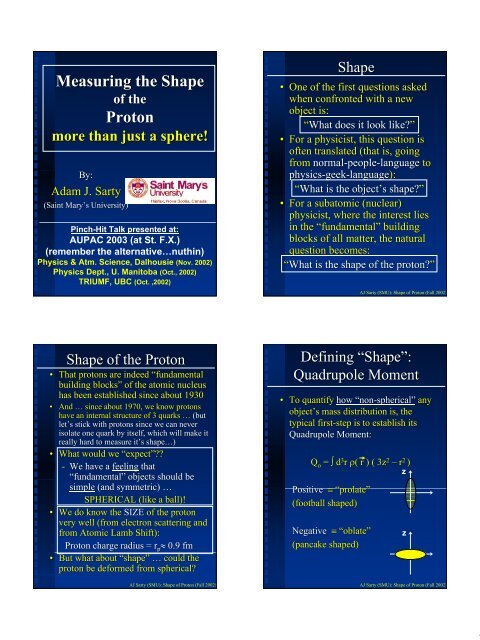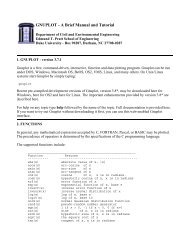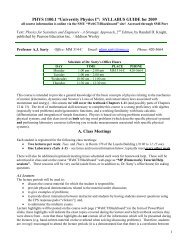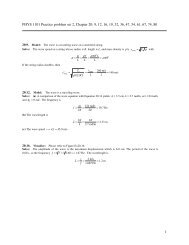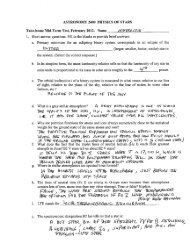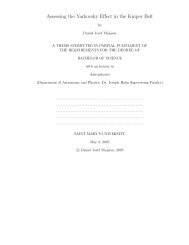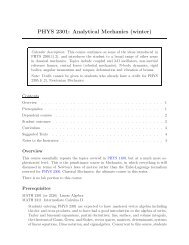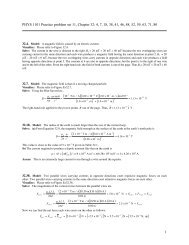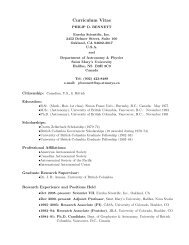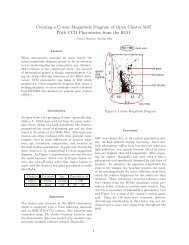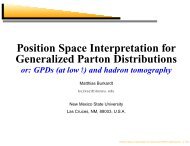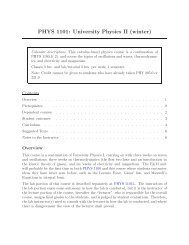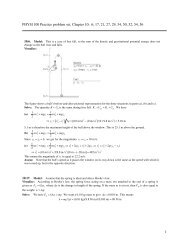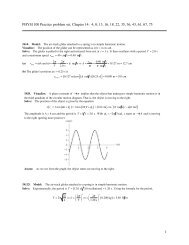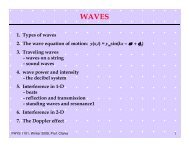Measuring the Shape Proton Measuring the Shape Proton
Measuring the Shape Proton Measuring the Shape Proton
Measuring the Shape Proton Measuring the Shape Proton
- No tags were found...
You also want an ePaper? Increase the reach of your titles
YUMPU automatically turns print PDFs into web optimized ePapers that Google loves.
<strong>Measuring</strong> <strong>the</strong> <strong>Shape</strong>of <strong>the</strong><strong>Proton</strong>more than just a sphere!By:Adam J. Sarty(Saint Mary’s University)Pinch-Hit Talk presented at:AUPAC 2003 (at St. F.X.)(remember <strong>the</strong> alternative…nuthin)Physics & Atm. Science, Dalhousie (Nov. 2002)Physics Dept., U. Manitoba (Oct., 2002)TRIUMF, UBC (Oct. ,2002)<strong>Shape</strong>• One of <strong>the</strong> first questions askedwhen confronted with a newobject is:“What does it look like?”• For a physicist, this question isoften translated (that is, goingfrom normal-peoplepeople-languagelanguage tophysics-geekgeek-language):“What is <strong>the</strong> object’s shape?”• For a subatomic (nuclear)physicist, where <strong>the</strong> interest liesin <strong>the</strong> “fundamental” buildingblocks of all matter, <strong>the</strong> naturalquestion becomes:“What is <strong>the</strong> shape of <strong>the</strong> proton?”AJ Sarty (SMU): <strong>Shape</strong> of <strong>Proton</strong> (Fall 2002)<strong>Shape</strong> of <strong>the</strong> <strong>Proton</strong>• That protons are indeed “fundamentalbuilding blocks” of <strong>the</strong> atomic nucleushas been established since about 1930• And … since about 1970, we know protonshave an internal structure of 3 quarks … (butlet’s stick with protons since we can neverisolate one quark by itself, which will make itreally hard to measure it’s shape…)• What would we “expect”??- We have a feeling that“fundamental” objects should besimple (and symmetric) …SPHERICAL (like a ball)!• We do know <strong>the</strong> SIZE of <strong>the</strong> protonvery well (from electron scattering andfrom Atomic Lamb Shift):<strong>Proton</strong> charge radius = r p ≈ 0.9 fm• But what about “shape” … could <strong>the</strong>proton be deformed from spherical?AJ Sarty (SMU): <strong>Shape</strong> of <strong>Proton</strong> (Fall 2002)Defining “<strong>Shape</strong>”:Quadrupole Moment• To quantify how “non-spherical”anyobject’s mass distribution is, <strong>the</strong>typical first-step step is to establish itsQuadrupole Moment:Q o = ∫ d 3 r ρ( ( r ) ( 3z 2 – r 2 )zPositive ≡ “prolate”(football shaped)Negative ≡ “oblate”(pancake shaped)zAJ Sarty (SMU): <strong>Shape</strong> of <strong>Proton</strong> (Fall 2002)
Quadrupole Momentof <strong>the</strong> <strong>Proton</strong>?• Unfortunately … we cannot evendefine <strong>the</strong> Quadrupole Moment for <strong>the</strong>proton (Quantum Mechanics gets in<strong>the</strong> way!)• For proton, <strong>the</strong> Q.M. would be <strong>the</strong>expectation value of <strong>the</strong> QuadrupoleMoment operator:< Q o > = < p | Q o | p > ≡ 0 !<strong>Proton</strong> w.f.:J = ½Quad. Moment Operator:Rank “2” (J = 2)<strong>Proton</strong> w.f.:J = ½• Angular Momentum Selection Rulesdictate this is zero ( J= ½ and J = 2cannot couple to give J= ½ ).AJ Sarty (SMU): <strong>Shape</strong> of <strong>Proton</strong> (Fall 2002)<strong>Proton</strong> <strong>Shape</strong> ano<strong>the</strong>r Way?…<strong>the</strong> Transition Quadrupole Moment• To access <strong>the</strong> proton’s intrinsic“shape” information, we need toby-passthis angular momentumselection rule problem …• Look at “shape” of Transitions to ahigher-J J excited state (been doing thiswith “heavy” J = 0 and J = ½ nucleifor about 40-50 years!).• The 1 st excited state of <strong>the</strong> proton is<strong>the</strong> ∆(1232), and it has J = 3/2 :< ∆ | Q o | p > = ? (shape info!)Delta w.f.:J = 3/2Quad. Moment Operator:Rank “2” (J = 2)<strong>Proton</strong> w.f.:J = ½• No angular momentum problem:( J=3/2 ) ⊗ ( J=2 ) → ( J= ½ ) AJ Sarty (SMU): <strong>Shape</strong> of <strong>Proton</strong> (Fall 2002)Accessing (Experimentally)<strong>the</strong> Transition Quadrupole Moment• Unfortunately (again!) … easier towrite “” ” than to measure!• The (ok… “my” !) preferred method:ELECTROMAGNETICALLY excite<strong>the</strong> proton to its first excited state, <strong>the</strong>∆ (1232), using real photons (gammarays) or virtual photons (electronscattering).As a Short “Aside” …<strong>Proton</strong> <strong>Shape</strong> even makes <strong>the</strong>NEWS…pγ *γ * + p → ∆(1232)∆(1232)• Incident particle is“shapeless”• EM interaction known• Excitation from “QuadrupolePhotons”(L = 2) will be a direct signature for aQuadrupole Transition Moment!AJ Sarty (SMU): <strong>Shape</strong> of <strong>Proton</strong> (Fall 2002)Sept. 22, 2002: USA Today –“Physicists thrown for a loop” …Story on shape of <strong>the</strong> proton being not exactly spherical!Based on interpretation of Jefferson Lab Hall A dataon elastic electron scattering from proton, byG. Miller (PRC 66, 032201(R), 2002):“Light front cloudy bag model:Nucleon electromagnetic form factors”AJ Sarty (SMU): <strong>Shape</strong> of <strong>Proton</strong> (Fall 2002)
Outline for (<strong>the</strong> rest of)<strong>the</strong> Talk…• Models (simple) of <strong>the</strong> <strong>Proton</strong>- Basis for understanding meaning of“shape” of proton- Explanations of <strong>the</strong> needed jargon(e.g. “multipoles“multipoles”)• Electron Scattering basics- Response Functions – and relationto multipoles- Status of World’s Data• Overview of 2 Experimental Projects:- “OOPS” at MIT-Bates- “FPP” in Hall A at Jefferson LabAJ Sarty (SMU): <strong>Shape</strong> of <strong>Proton</strong> (Fall 2002)A Starting Pointfor discussing proton structure:The Constituent Quark Model• Basis: : 3 “heavy” valence quarks,each with spin-parity:parity: S π = ½ +• Angular Momentum Coupling:<strong>Proton</strong> (J(π = ½ + ) ∆ (J π = 3/2 + )J = L ⊗ SS = [ ( ½ ⊗ ½ ) 0 , 1 ⊗ ½ ] = ½ or 3/2L: 0, 1, or 2 could work…PARITY:π = (π(q-1 )(π q-2 )(π q-3 )(−1) L= (+)(+)(+)(−1) L = (−1)(LSo: L = 0 or 2½ = 0 ⊗ ½ “spherical” 3/2 = 0 ⊗ 3/2½ = 2 ⊗ 3/2 3/2 = 2 ⊗ ( ½, , 3/2)“deformed”AJ Sarty (SMU): <strong>Shape</strong> of <strong>Proton</strong> (Fall 2002)Simplest Structure:Spherical (L = 0)• Complete Spherical Symmetry:L = 0 in both proton and Deltaone quarkspin flipJ π = ½ + J π = 3/2 +• Indeed … <strong>the</strong> dominantly observedtransition is this simple spin-flip …• So, <strong>the</strong> proton is “mostly spherical”• The issue is to measure how muchL=2 component exists in <strong>the</strong>sestates – this is <strong>the</strong> measure of“deformation from spherical”.• Let’s now examine EM excitationof <strong>the</strong> transition (allowing for <strong>the</strong>L=2 components) …AJ Sarty (SMU): <strong>Shape</strong> of <strong>Proton</strong> (Fall 2002)What “kind” (MULTIPOLE) of Photoncan Excite p → ∆?γ * + p → ∆(1232)(L π γ ⊗ ½ + = 3/2 + )• Conserve Parity: : Final π is +, so …π initial = (π(γ )(π proton ) = (π(γ )(+) ) = +• So photon’s s parity is Even.• Recalling Parity of EM Multipoles:- Electric: EL = (-1)(L- Magnetic: ML = (-1)(L+1- Scalar (or Coulomb): CL = (-1)(L• So…L π γ = 1 + ⇔ M1 (magnetic dipole)orL π γ = 2 + ⇔ E2, C2 (quadrupole!)• M1 is dominant (spin flip!)• Let’s s see “meaning” of E2 and C2 …AJ Sarty (SMU): <strong>Shape</strong> of <strong>Proton</strong> (Fall 2002)
Existence of E2 or C2:Implies L=2 (“Deformation”) !• In <strong>the</strong> simple CQM:Let <strong>the</strong> |N> and |∆> | > w.f. be linearcombinations of <strong>the</strong> 3 valence quarksin L=0 and L=2 statesWhat Physics do we Learn byStudying “Deformation”(<strong>the</strong> L=2 states)?• Valence Quark picture (CQM):- “ColourHyperfine Interaction”:a tensor force (analogous to <strong>the</strong>NN tensor force introducingmixing of L=0 and L=2 states in<strong>the</strong> deuteron)(mechanism: 1-gluon 1exchange?)Beyond <strong>the</strong> Simple CQM …Non-Valence Quark D.O.F. (qqor π’s!)(from Buchmann & Henley, PRC 63, 015202)AJ Sarty (SMU): <strong>Shape</strong> of <strong>Proton</strong> (Fall 2002)Valence (1-quark)Non-Valence (2-quark)AJ Sarty (SMU): <strong>Shape</strong> of <strong>Proton</strong> (Fall 2002)Physics of Deformation (continued):Quark Interactions vs. Pion Cloud• Existence of E2 or C2 excitations maynot mean L=2 valence quarkcomponents (i.e. may not be probingdirect quark-quark interaction)• Possible presence of 2-quark 2currentsallows E2 or C2 with L=0 valence q’sPhysics of Deformation (continued):Quark Interactions vs. Pion Cloud• However, existence of E2 or C2 excitationsstill means “deformed“proton”…• A popular model of <strong>the</strong> 2-quark 2currents is <strong>the</strong> presence of a(deformed) “PION CLOUD”surrounding <strong>the</strong> valence quarks.(from Buchmann & Henley, PRC 63, 015202)AJ Sarty (SMU): <strong>Shape</strong> of <strong>Proton</strong> (Fall 2002)• Rationale: : long-range structuredetermined by lightest GoldstoneBoson (again, not dissimilar to <strong>the</strong>case in <strong>the</strong> deuteron!)AJ Sarty (SMU): <strong>Shape</strong> of <strong>Proton</strong> (Fall 2002)
ELECTRON SCATTERING:How do we Really access this information??• Pick a “final state” (∆ doesn’t live long!)• Detect more than just scattered e’• need to disentangle L=0, L=2 …M1, E2 or C2CMS energy (4-mom. Transfer) 2AJ Sarty (SMU): <strong>Shape</strong> of <strong>Proton</strong> (Fall 2002)The “Rest of <strong>the</strong> Story”on Multipoles…• We now need “more” than just <strong>the</strong>photon’s M1, E2 or C2 properties:Ensure “final state” from ∆(1232) decay∆(1232) → p + π 0J π = 3/2 + → [ (½ + ⊗ 0 - ) s ⊗ l ]S π = ½ +• So, Constraints on l(<strong>the</strong> relative angular momentum of<strong>the</strong> pπp0 pair in Final State):1. Can have: l + ½ = 3/2 (i.e. l = 1)or l – ½ = 3/2 (i.e. l = 2)2. MUST conserve Parity: : final π = +π final = (π(π )(π proton ) (-1)(l = (+)(-) (-1)l+ = (-1)l +1 … so: l = ODD∴ l = 1AJ Sarty (SMU): <strong>Shape</strong> of <strong>Proton</strong> (Fall 2002)The Full Multipole Labelsfor Pion Electroproduction from <strong>the</strong> <strong>Proton</strong>:• The Dominant “Spherical” (single-quark spin-flip) Transition:l = 1Magnetic photon(must be M1)M 1+• The smaller “Deformed” (quadrupole(quadrupole)Transitions:E 1+ and S 1+(with E meaning “electric“electric” ” photon,and S meaning “scalar“scalar” ” photon)- The “S” can also be written “L”“(“longitudinallongitudinal” ” photon)J = l + ½• Represent COMPLEX Tx Amplitudes• Strength of “Quadrupole“Quadrupole” multipolesdefined with reference to dominantamp:EMR ~ E 1+ / M 1+CMR ~ S 1+ / M 1+AJ Sarty (SMU): <strong>Shape</strong> of <strong>Proton</strong> (Fall 2002)Isolating ∆-Excitation(<strong>the</strong> RESONANT M 1+ , E 1+ , S 1+ )• Can use:• polarization (spin)• Complete angular distributionsTo isolate desired multipole pieces(more on this in a minute!)AJ Sarty (SMU): <strong>Shape</strong> of <strong>Proton</strong> (Fall 2002)
One Last Model Prediction!Sato/Lee, PRC 63 (2001) 055201:Pion-exchange modelIm( M 1+ )Letting <strong>the</strong> Cat out of <strong>the</strong> Bag:Real Photons show Deformation!1997No pion cloudIm( E 1+ )Full calc.Im( S 1+ )At Low Q 2 :Sensitive to long-range structure: Pion cloudAs Q 2 increases:Pion cloud effects ↓, Valence quark effects ↑AJ Sarty (SMU): <strong>Shape</strong> of <strong>Proton</strong> (Fall 2002)• Won’t discuss <strong>the</strong>se here…but <strong>the</strong>y usedSPIN (Polarized Photon Asym) ) in a wayanalogous to what I’ll show with γ * .AJ Sarty (SMU): <strong>Shape</strong> of <strong>Proton</strong> (Fall 2002)Pursuing <strong>the</strong> Details of Deformation:Electron Scattering! (still many exps)Existing Data for SMR & EMRas of 2000:SMREMR• Q 2 dependence maps out dynamics ofrelevant d.o.f. at varying distance scales(e.g. pion cloud to valence quarks)• Can only get C2 information from γ*‣Gives more direct access to w.f.structure (direct probe of charge dist.)AJ Sarty (SMU): <strong>Shape</strong> of <strong>Proton</strong> (Fall 2002)
Response Definitions:• Each Response (and Polarization)provides unique combinations ofcontributing multipoles.Response Functions → MultipolesWrite relations for R’s that do not needrecoil proton polarization:Measure φ depend. or p polarization to separate!18 R’s!AJ Sarty (SMU): <strong>Shape</strong> of <strong>Proton</strong> (Fall 2002)• Once R’s are isolated (through(measuredφ dependence), need also opening angle(θ) distribution to decomposemultipoles...AJ Sarty (SMU): <strong>Shape</strong> of <strong>Proton</strong> (Fall 2002)Response Functions → MultipolesSome General Comments• Too many competing multipoles toextract <strong>the</strong>m model independently from<strong>the</strong> cross section angular dist’s.• To minimize model dependence indetermination of <strong>the</strong> multipoles,Ei<strong>the</strong>r:- Measure more R’s, since each R has aunique combination of multipoles (dothis by measuring recoil protonpolarization! 13 more R’s accessible)Or- Make an approx. truncated expansion• ALL of <strong>the</strong> World’s CMR,EMR data sofar have used a simplified expansion:- Keep only terms with an M 1+- Use only l = 0, 1EXPERIMENT OVERVIEW #1:The Out-of-Plane Spectrometers(OOPS)At MIT-Bates Linear Accelerator• Focus on Low-Q2 region(beam energy is 1 GeV maximum)• Can access <strong>the</strong> 5 R’s obtainable withoutmeasuring recoil pol.:- Use polarized beam, measureazimuthal (φ)) distribution• Getting <strong>the</strong> φ distribution is hard!- Not a large CMS→LAB“kinematicfocusing” boost effect- So “cone” of emitted protons isphysically big (full 180 degrees ofproton opening angle in CMS folds toaround 50 degrees in LAB).AJ Sarty (SMU): <strong>Shape</strong> of <strong>Proton</strong> (Fall 2002)AJ Sarty (SMU): <strong>Shape</strong> of <strong>Proton</strong> (Fall 2002)
Place 4 Identical Spectrometers at keyAzimuthal Angles (φ) at Fixed θThe Real OOPS!4 Identical Spectrometers and aSophisticated Support SystemAJ Sarty (SMU): <strong>Shape</strong> of <strong>Proton</strong> (Fall 2002)AJ Sarty (SMU): <strong>Shape</strong> of <strong>Proton</strong> (Fall 2002)Proof I once worked on OOPS!OOPS: Sensitivity to “Deformation” in<strong>the</strong> R LT ResponseMertz et al., PRL 86 (2001) 2963Kunz, MIT PhD (2000); in prep for PRLThanks to I. Nakagawa, C.Kunz, andA. Bernstein for use of OOPS slides in this talk.AJ Sarty (SMU): <strong>Shape</strong> of <strong>Proton</strong> (Fall 2002)• This is a comparison to one particularphenomenological isobar model … BUTmodel-toto-model comparisons still unclear.AJ Sarty (SMU): <strong>Shape</strong> of <strong>Proton</strong> (Fall 2002)
OOPS: Model Dependence in<strong>the</strong> R LT ResponseMertz et al., PRL 86 (2001) 2963• No model can successfully describe <strong>the</strong>W-dependence of all acquired data.• Relevance: : resonant and non-resonantcontributing multipoles have differentdependence of W.AJ Sarty (SMU): <strong>Shape</strong> of <strong>Proton</strong> (Fall 2002)EXPERIMENT OVERVIEW #2:Recoil <strong>Proton</strong> Polarization using<strong>the</strong> High Resolution Spectrometersin Hall A at Jefferson Lab• E91-011 at JLab: : data acquired May-August 2000 (preliminary(results today)• Higher Q 2 ( = 1.0 GeV 2 ): largerCMS→LAB“kinematicfocusing” boostmakes getting <strong>the</strong> φ distribution easier(no need for multiple OOPS’s!)• Use Recoil <strong>Proton</strong> Polarimetry to accessmany more R’s! R• Measure a full θ distribution also tofacilitate reduction in model dependenceof multipole extraction!• Note: : <strong>the</strong> polarization R’s R s allow accessto “phase information” of <strong>the</strong>contributing multipoles (by beingsensitive to Imaginary parts).AJ Sarty (SMU): <strong>Shape</strong> of <strong>Proton</strong> (Fall 2002)Collaboration List…Spokespeople and PhD StudentsAJ Sarty (SMU): <strong>Shape</strong> of <strong>Proton</strong> (Fall 2002)
Hall A Facility for Performing Measurement• Beam Polarization mid-high 70%’s• Average current (whole run) = 45 µA(143 C): HIGHEST: 108.2 µA, P=79%Hall AFocal Plane Polarimeter:(FPP)Tools in Hall A:• 2 Hi-Res Specs(6 msr each)• FPP• High I, high Pol.cw beam• 15 cm LH2cryotarget• E 0 up to 5 GeVAJ Sarty (SMU): <strong>Shape</strong> of <strong>Proton</strong> (Fall 2002)Hall A E91-011 MeasuredCross Section Angular Distributions(PRELIMINARY!)UPDATED World’s Data forEMR & CMR (as of now!)• Each “box” above is a bin in φ, , showingopening angle (θ)() distribution.• With JUST this cross section data, we cando <strong>the</strong> same “simplified” EMR & CMRextraction as earlier experiments …AJ Sarty (SMU): <strong>Shape</strong> of <strong>Proton</strong> (Fall 2002)• A LOT of NEW data from Hall B’s“CLAS” at JLab (Jooet al., PRL, 2002) –from extensive cross section distributions• Our Prelim points from Cross SectionsOnly (blue(points) ) in agreement …AJ Sarty (SMU): <strong>Shape</strong> of <strong>Proton</strong> (Fall 2002)
BUT! We now have <strong>the</strong> Recoil <strong>Proton</strong>Polarization Measurements!6 components:3 for “induced” Polarization3 for “transferred” PoalrizationHelicity-Dependent Polarized R’s(“transferred” – need pol. Beam)• The small differences between <strong>the</strong> twophenomenological models shown(“SAID” and “MAID”) dominated byresonant “1+” amplitudes.AJ Sarty (SMU): <strong>Shape</strong> of <strong>Proton</strong> (Fall 2002)AJ Sarty (SMU): <strong>Shape</strong> of <strong>Proton</strong> (Fall 2002)Helicity-Independent Polarized R’s(“induced” – don’t need pol. Beam)PRELIMINARY Attempt to ExtractMultipoles from ALL of E91-011 Data(cross section and polarization angulardistributions!)• EPIPROD program by J.J. Kelly, U. Maryland• The now larger differences between <strong>the</strong>two phenomenological models shown(“SAID” and “MAID”) arises from lackof knowledge of <strong>the</strong> non-resonantmultipole amplitudes (“background”).AJ Sarty (SMU): <strong>Shape</strong> of <strong>Proton</strong> (Fall 2002)AJ Sarty (SMU): <strong>Shape</strong> of <strong>Proton</strong> (Fall 2002)
SUMMARY• The <strong>Proton</strong> is not purely spherical!• There continue to be ongoingexperimental efforts to fullycharacterize <strong>the</strong> amount of“quadrupoledeformation”.• Challenging experimentally:- Full angular distributions needed- Polarized electron beam needed- Recoil proton polarimetry needed- Need to separate resonant and non-resonant contributions• When completed…will provide new& valuable insight into our vision of<strong>the</strong> proton’s structure.AJ Sarty (SMU): <strong>Shape</strong> of <strong>Proton</strong> (Fall 2002)


